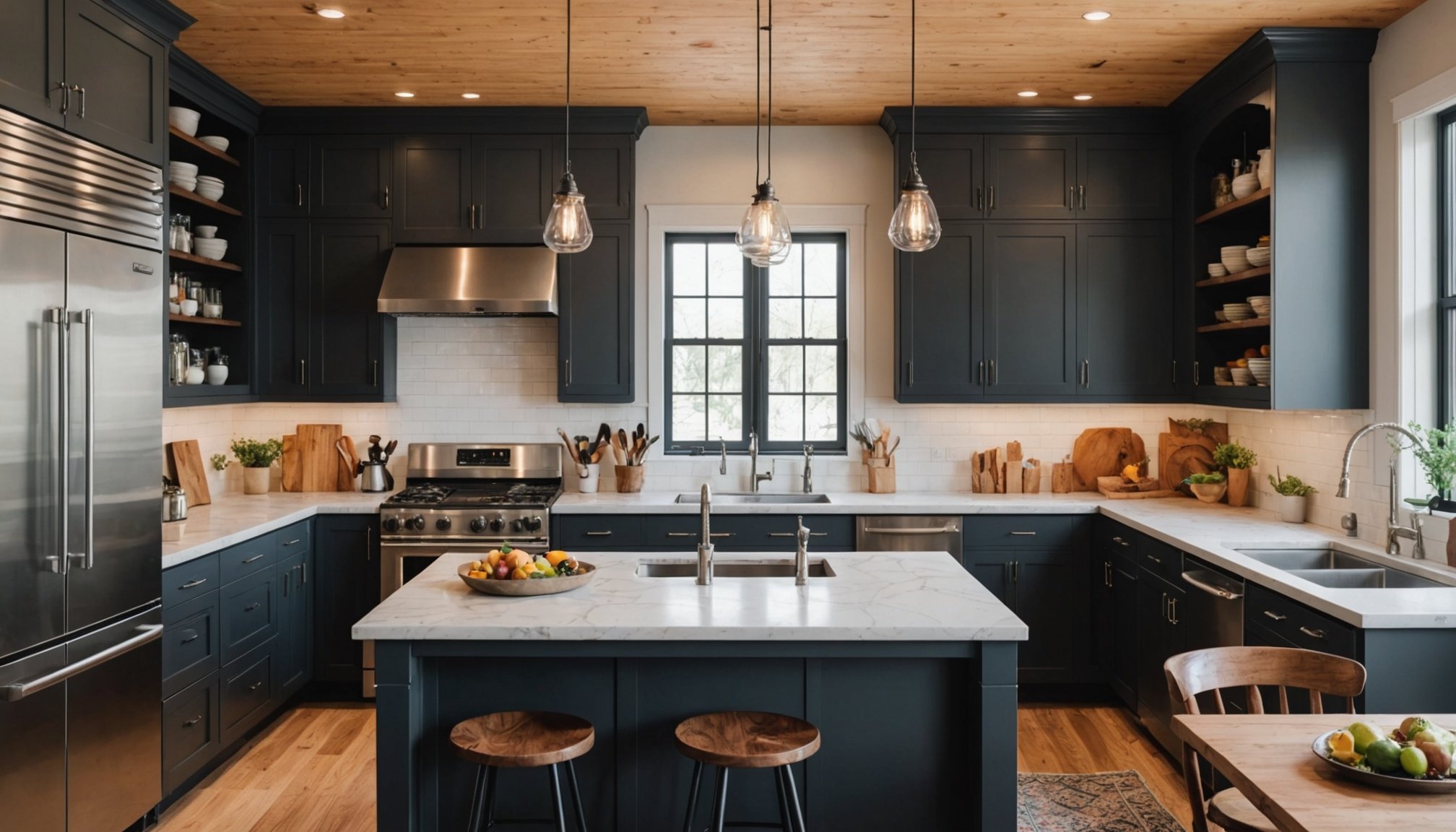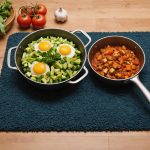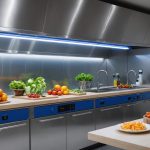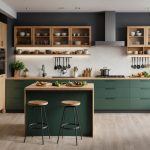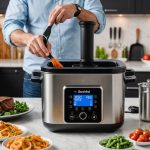Creating a kitchen that caters to both meat lovers and plant-based chefs requires thoughtful design and flexibility. By blending cooking zones, storage solutions, and essential tools, home cooks can enjoy a harmonious space. This article explores innovative strategies to accommodate diverse culinary preferences while maintaining style and function. Discover how to elevate your kitchen experience, no matter your diet.
Understanding the Needs of Diverse Chefs
Exploring the integration of diverse cooking styles in kitchen design.
In parallel : Exploring the Hottest Kitchen Island Trends Featuring Integrated Dining Tables
Accommodating Cooking Styles
Designing a kitchen that caters to both meat-based and plant-based cooking styles is an essential consideration for diverse chefs. A well-thought-out kitchen design can enhance efficiency and harmony.
Common Cooking Tools
Also to see : Discover the Hottest Eco-Friendly Kitchen Cabinet Trends Revolutionizing Sustainability in 2023
- Knives: Essential for chopping both meats and vegetables.
- Cutting Boards: Separate boards for meat and plant-based ingredients prevent cross-contamination.
- Pots and Pans: Different sizes and materials cater to various cooking needs.
Ingredients and Workflow
A dual-purpose kitchen must accommodate a range of ingredients and workflows. Meat-based cooking often requires specific storage solutions for raw meats, while plant-based diets might need space for fresh produce and grains. Understanding these needs ensures a seamless cooking experience.
Workflow Differences
- Storage: Allocate separate spaces for meat and plant-based items.
- Preparation Areas: Designate zones to prevent cross-contamination.
- Cooking Surfaces: Multiple stovetops or ovens can support diverse cooking practices.
By focusing on these aspects, chefs can create a kitchen environment that respects and enhances their culinary diversity. This approach not only boosts efficiency but also encourages creativity and experimentation in the kitchen.
Kitchen Layout and Design Principles
Exploring versatile kitchen layouts for diverse culinary practices.
Open Concept vs. Separate Zones
When considering versatile kitchen layouts, chefs often debate between an open concept and separate zones for meat and plant-based cooking. An open concept encourages fluid movement and social interaction, ideal for those who enjoy entertaining while cooking. Conversely, separate zones help maintain organization and reduce cross-contamination, making them suitable for chefs who frequently switch between diverse cooking styles.
Efficient Work Triangle
The work triangle—connecting the sink, stove, and refrigerator—remains a cornerstone of kitchen design. An efficient work triangle minimizes unnecessary steps and enhances productivity. In a versatile kitchen, placing these elements strategically supports both meat-based and plant-based cooking, allowing chefs to transition seamlessly between tasks.
Multifunctional Islands
Incorporating multifunctional islands can revolutionize a kitchen's functionality. These islands serve as prep areas, dining spaces, and storage solutions. For chefs balancing diverse cooking styles, islands offer additional counter space and can be equipped with specialized tools or appliances.
Benefits of Multifunctional Islands:
- Extra storage for diverse ingredients
- Additional seating for social engagement
- Versatile prep area for various cooking needs
By integrating these design principles, a kitchen can become a dynamic space that fosters creativity and efficiency, catering to the unique needs of every chef.
Storage Solutions for Diverse Ingredients
Optimizing kitchen storage for various diets.
Best Practices for Organization
Efficient kitchen storage for various diets is crucial for maintaining order and avoiding cross-contamination. Organizing meat and plant-based ingredients separately is a primary best practice. Consider using distinct labeled storage containers to clearly differentiate between items.
Utilizing Pull-Out Shelves and Drawers
Incorporating pull-out shelves and drawers enhances accessibility and organization. These features allow easy access to stored goods, making it simpler to manage both meat and plant-based ingredients. Pull-out systems can be customized to fit different container sizes, ensuring that each diet type has designated space.
Tips for Labeled Storage
Clear labeling is a simple yet effective solution to prevent mix-ups. Use labels to identify meat and plant-based ingredients. This practice not only enhances efficiency but also promotes a hygienic cooking environment.
Labeled Storage Tips:
- Use waterproof labels for durability
- Color-code for quick identification
- Regularly update labels to reflect contents
By implementing these strategies, chefs can create a streamlined and safe kitchen environment. Kitchen storage for various diets becomes manageable, supporting the diverse needs of culinary enthusiasts. This organized approach fosters a seamless workflow, encouraging creativity and experimentation.
Essential Appliances for a Versatile Kitchen
Maximize culinary potential with the right tools.
Recommended Appliances
To create a versatile kitchen that caters to both meat-based and plant-based cooking, certain appliances are indispensable. A high-quality blender is perfect for making smoothies, soups, and sauces, serving both cooking styles efficiently. An induction cooktop offers precise temperature control, crucial for delicate plant-based dishes and searing meats.
Features to Look For
When selecting kitchen appliances for diverse cooking, prioritize features that enhance functionality. Look for appliances with multi-functionality, such as ovens with steaming and roasting capabilities. Smart appliances with programmable settings can adapt to various culinary techniques, ensuring a seamless cooking experience.
Energy-Efficient Options
Energy efficiency is a key consideration for all types of chefs. Choose appliances with an Energy Star rating to reduce electricity consumption without sacrificing performance. Induction cooktops are notably energy-efficient, heating food directly and minimizing heat loss.
Key Appliances for Diverse Cooking:
- Blender: Versatile for multiple dishes
- Induction Cooktop: Precise and efficient
- Smart Oven: Multiple cooking modes
By integrating these kitchen appliances for diverse cooking, chefs can enhance their culinary space, making it adaptable and efficient. This thoughtful selection fosters an environment that supports creativity while maintaining sustainability.
Cooking Tools and Utensils for All Chefs
Exploring essential kitchen tools for diverse culinary practices.
Key Kitchen Tools
To cater to both meat-based and plant-based cooking, certain kitchen tools are indispensable. A sharp chef's knife is versatile for slicing meats and chopping vegetables. Cutting boards are crucial; using separate ones for meat and plant-based ingredients prevents cross-contamination. A sturdy cast iron skillet is perfect for searing meats while also ideal for plant-based stir-fries.
Safe Food Prep Tools
Ensuring food safety is paramount. Opt for color-coded cutting boards to distinguish between meat and plant-based prep areas. This practice minimizes the risk of cross-contamination. Additionally, consider using silicone spatulas that are easy to clean and resistant to bacteria.
Essential Tools:
- Chef's Knife
- Cast Iron Skillet
- Color-coded Cutting Boards
- Silicone Spatulas
Recommended Brands
Durability is key when selecting kitchen tools. Brands like Wüsthof for knives, Lodge for cast iron skillets, and OXO for kitchen utensils are highly recommended. These brands offer reliable products that withstand the demands of diverse cooking styles.
By integrating these kitchen tools, chefs can confidently create a safe and efficient culinary environment, accommodating both meat and plant-based cooking practices.
Meal Prep Strategies for Mixed Diets
Strategies to accommodate diverse culinary preferences.
Planning Meals
Meal prep for diverse diets requires thoughtful planning to balance both meat-based and plant-based preferences. Start by identifying common ingredients that can be used in both types of meals. For example, grains, legumes, and vegetables can serve as a base for various dishes. Planning meals around these shared ingredients simplifies the process and reduces the need for separate preparations.
Batch Cooking Techniques
Batch cooking is an efficient strategy for meal prep for diverse diets. Prepare large quantities of versatile components like roasted vegetables, grains, or sauces. These can be mixed and matched throughout the week to create different meals. For instance, roasted chickpeas can be added to a salad for a plant-based option or used as a side with grilled chicken.
- Roasted Vegetables: Ideal for both diet types
- Grains: Quinoa, rice, or couscous
- Sauces: Universal dressings or marinades
Flavor Pairings
Understanding flavor pairings that cater to both cooking styles enhances the meal prep experience. Herbs like basil and spices such as cumin can elevate both meat and plant-based dishes. Experimenting with these pairings ensures that meals are flavorful and satisfying for all preferences.
Visual Inspiration for a Versatile Kitchen
Explore design ideas that enhance culinary diversity.
Gallery of Successful Kitchen Designs
Creating a versatile kitchen involves integrating elements that cater to diverse cooking practices. A gallery of successful kitchen designs showcases how thoughtful layouts can enhance functionality. One example features a sleek, modern kitchen with neutral color schemes that seamlessly blend meat-based and plant-based cooking areas. The use of stainless steel and natural wood materials adds a touch of warmth and versatility.
Color Schemes and Materials
Color schemes play a crucial role in kitchen design inspiration. Opt for a palette that promotes versatility, such as soft grays or muted greens, which provide a calming backdrop for culinary creativity. Materials like quartz countertops are not only durable but also complement various design styles, making them ideal for a dual-purpose kitchen.
Real-Life Examples of Functional Dual-Purpose Kitchens
Real-life examples offer practical insights into functional kitchen design. Consider a kitchen that incorporates an island with dual sinks and ample storage, allowing for efficient meal prep. Another showcases open shelving, which is both aesthetically pleasing and practical, encouraging organization and accessibility.
- Neutral Color Schemes: Soft grays, muted greens
- Materials: Stainless steel, natural wood, quartz
- Design Features: Dual sinks, open shelving
By drawing inspiration from these examples, chefs can create a versatile kitchen that supports diverse culinary practices with style and efficiency.
Creating a Comfortable Cooking Environment
Enhancing your kitchen ambiance and ergonomics for an enjoyable cooking experience.
Importance of Lighting and Ventilation
Lighting and ventilation are pivotal in crafting a pleasant cooking environment. Proper lighting not only illuminates your workspace but also enhances kitchen ambiance. Consider installing adjustable LED lights to suit different cooking tasks. Ventilation is equally crucial; a well-ventilated kitchen prevents odors from lingering and maintains air quality. Range hoods and exhaust fans are effective solutions.
Ergonomic Considerations
Ergonomics play a vital role in ensuring comfort while cooking. Arrange your kitchen so that frequently used items are within easy reach. Adjustable countertops and anti-fatigue mats can significantly reduce strain during prolonged cooking sessions. Ensure that the kitchen layout supports natural movement to enhance overall efficiency.
Incorporating Personal Touches
Personalizing your cooking space can boost the kitchen ambiance and make it more inviting. Displaying favorite cookbooks, incorporating family photos, or using vibrant dishware can add warmth and character. Personal touches not only make the kitchen feel welcoming but also reflect your unique style.
- Lighting: Adjustable LED options
- Ventilation: Range hoods, exhaust fans
- Ergonomics: Adjustable countertops, anti-fatigue mats
By focusing on these aspects, you can transform your kitchen into a comfortable and efficient space that enhances your culinary experience.
Recipes That Cater to Both Meat Lovers and Plant-Based Chefs
Exploring culinary diversity with adaptable recipes.
Sample Recipes for Diverse Diets
Creating meals that satisfy both meat lovers and plant-based chefs can be an exciting culinary adventure. Consider a stir-fry that features tofu and chicken, allowing each diner to choose their preference. The base ingredients like bell peppers and broccoli remain constant, providing a harmonious blend of flavors.
Versatile Ingredients
Versatile ingredients are key to crafting recipes for diverse diets. Quinoa is an excellent choice, offering a protein-rich base that complements both grilled vegetables and roasted meats. Chickpeas can be roasted for a crunchy side or blended into a creamy hummus, appealing to all taste buds.
- Quinoa: Protein-rich, adaptable
- Chickpeas: Versatile, nutritious
- Bell Peppers: Colorful, flavorful
Encouraging Creativity
Encourage creativity by combining flavors and textures. A salad can be transformed with the addition of avocado and grilled steak or tempeh, offering a delightful mix for both diets. Experiment with spices like cumin and coriander to enhance the dish's complexity.
A quote from chef Alice Waters encapsulates this approach: "Cooking is about balance; it's about taste and texture." By embracing this philosophy, chefs can craft recipes that cater to both meat lovers and plant-based chefs, fostering a shared culinary experience.
Maintaining a Clean and Safe Cooking Space
Ensuring hygiene and safety in a mixed dietary kitchen.
Best Practices for Kitchen Cleanliness
Maintaining kitchen hygiene for mixed dietary cooking is essential for a safe cooking environment. Implementing best practices can prevent cross-contamination and ensure allergen safety. Start by using separate cleaning tools for different cooking zones. This includes using distinct sponges and towels for meat-based and plant-based areas.
Importance of Separate Cooking Zones
Creating distinct cooking zones is crucial for maintaining kitchen hygiene. Designate specific areas for preparing meat and plant-based meals to avoid allergen exposure. This separation helps in preventing cross-contamination, ensuring a hygienic cooking environment.
Benefits of Separate Cooking Zones:
- Reduces risk of cross-contamination
- Enhances allergen safety
- Promotes organized workflow
Regular Maintenance Tips
Regular maintenance is vital for preserving kitchen hygiene. Clean surfaces and appliances after each use, and schedule deep cleaning sessions weekly. Ensure that ventilation systems are functioning properly to maintain air quality.
Maintenance Tips:
- Wipe down surfaces after each meal
- Deep clean weekly
- Check ventilation regularly
By adhering to these practices, chefs can maintain a clean and safe cooking space, accommodating diverse dietary needs while supporting a healthy culinary environment.

